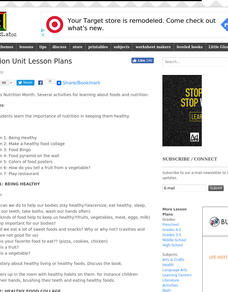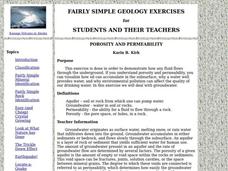Curated OER
Nutrition Unit
Students complete a number of activities to learn about food and nutrition. They listen to stories, make a collage, play food bingo, and examine the food pyramid as they investigate healthy eating choices.
Curated OER
What Lives Inside Your Mouth?
Young scholars explore the mouth's environment and realize that there are bacteria in everyone's mouth.
Curated OER
Let's Investigate Tooth Decay
Learners conduct a simple investigation to explore tooth decay.
Curated OER
Ancient Refuge in the Holy Land - International Phonetic Alphabet
Students research the uses and symbols of the International Phonetic Alphabet. They complete a worksheet to translate and transcribe phrases of English into the International Phonetic Alphabet.
Curated OER
Broken Bones
Students listen to a lecture on broken bones. They review the proper first aid techniques and practice setting splints on one another. They observe X-rays and animal bones.
Curated OER
Living Tobacco Free
First graders explore how smoking and tobacco are made of harmful substances.
Curated OER
Just Breathe
Students examine the inhalation and exhalation process. They create a model pair of lungs from given materials. They discover the technology that has been developed based on engineers examining the respiratory system.
Curated OER
Porosity And Permeability
Students participate in an exercise/experiment designed to show how environmental pollution can affect the quality of drinking water.
Curated OER
Respiratory System
Pupils identify the parts of the respiratory system and how they interact. They define vocabulary words and draw an outline of themselves and label the parts of the respiratory system. They distinguish between healthy and unhealthy...
Curated OER
Fertilized Death Water
Learners investigate the effect of chemicals on Platyhelminthes and planaria development. They observe the growth and development of planaria and investigate what fertilizer can do to living organisms when it is introduced into their...
Curated OER
Do You Have the Guts?
Seventh graders Name and locate the major internal organs of the human body and the frog. Students virtually dissect a frog and compare organs to the human organs. Students draw illustrations of their learnings.
Curated OER
Brush Up On Your Teeth
Third graders examine the reasons why it is important to take care of their teeth. As a class, they sing the toothbrush song and read about tooth decay. They identify the parts of the teeth and identify foods that can keep the mouth...
Curated OER
Health In Progress/ Soft Drinks
Students engage in a lesson that is concerned with the consumption of soft drinks by children. They examine the statistics about the consumption and determine the increase or decrease in individual servings consumed over time. They...
Curated OER
Teeth Scramble
In this health worksheet, learners unscramble the eleven words that are related to the topic of teeth. The correct answers are written in the spaces provided.
Curated OER
Questions regarding the Digestive System
In this science related worksheet, students locate and answer thirty three multiple choice questions regarding the digestive system in humans.
Curated OER
Sponges
In this sponges worksheet, students will explore the characteristics of sponges including their different types of cells and body structures. Students will also determine how sponges reproduce. This worksheet has 3 short answer and 11...
Curated OER
Cnidarians
In this cnidarians worksheet, students will read 4 descriptions and identify each as either the polyp or medusa form of cnidarian. Then students will complete 3 short answer questions about the characteristics of cnidarians. Finally,...
Curated OER
Protection, Support, and Locomotion
In this human body instructional activity, students will review 5 terms associated with the skin by filling in the blank. Then students will read 14 statements about the human skeleton and muscles and determine if its true or false.
Curated OER
Watchable Wildlife Checklist
In this wildlife worksheet, students will read over a list of 28 native animal species, their needs, and interesting characteristics. This list can be used as a checklist when out on a hike or in the school yard to identify common wildlife.
Curated OER
Geologic Time
In this geologic time worksheet, students review how fossils were formed and the events that mark the various geological eras and periods. This worksheet has 10 fill in the blank and 9 short answer questions.
Curated OER
Muscles for Locomotion
For this muscles worksheet, students review the characteristics of the 3 types of muscles: smooth, skeletal, and cardiac. This worksheet has 7 matching and 4 short answer questions.
Curated OER
Mammals
In this mammals learning exercise, students review terms associated with the different types of mammals. This learning exercise has 6 fill in the blank and 4 matching questions.
Curated OER
Sponges, Cnidarians, Flatworms, and Roundworms
In this simple animals worksheet, students review the characteristics of sponges, cnidarians, flatworms, and roundworms. This worksheet has 12 matching questions.
Curated OER
Mollusks and Segmented Worms
In this mollusks and segmented worms learning exercise, students read information about these two groups of organisms and compare and contrast their general characteristics. This learning exercise has 2 short answer questions.
Other popular searches
- Body Cavities
- Body Planes and Cavities
- Human Body Cavities
- Cavities and Teeth
- Grids Cavities
- Tooth Cavities
- Eight Body Cavities
- Preventing Cavities
- Pleural Cavities
- Major Body Cavities
- Major Human Body Cavities
- Body Cavities and Regions

























